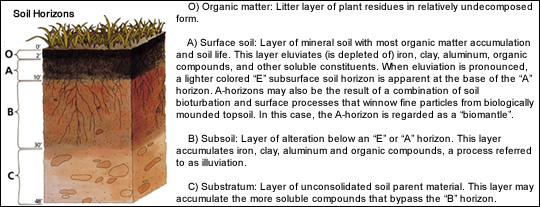Soil is made up of weathered rock with a small, but crucial, organic content that distinguishes it from other weathered material which has no organic component.
Weathering of the parent rock, climate, vegetation and surface slope are the main influences on the processes that determine the actual type of soil.
Soil Parent Material
All soils form a blanket over underlying rock. In most situations this rock has been broken down by physical and chemical weathering processes to produce the mineral component of the soil.
The mineral fraction can range in size from coarse gravel to minute particles of clay and is largely responsible for the texture of the soil.
The products of the chemical decomposition of the parent rock's minerals also determine the way in which a soil develops, and its fertility.
Clay minerals, which result from the chemical breakdown of silicates such as feldspar, are especially important, because they can retain vital nutrients until they are required by growing plants.
Igneous rocks tend to form rich soil, whereas the soil produced from sedimentary rocks varies; sandstones weather to form thin acid soils, limestones thin alkaline soils, and shales have little influence.
The formation of a mature soil from a bare rock surface takes approximately 10,000 years. In this time other controlling influences also exert their effects, reducing the importance of the parent rock as the soil develops.
Soil and Climate
Climate is an important element in soil formation and is often the basis for soil classification. It influences the soil by dictating the dominant weathering processes that affect the parent rock.
As the mineral fraction of the soil accumulates, temperature influences the degree of biological activity that occurs and also the amount of water in the soil.
Soil water, particularly rainfall, also plays an important role. Excess water seeps through the soil and may remove soluble minerals and fine solids, whereas too little water can slow the breakdown of minerals that are the source of vital nutrient chemicals.
Effects of Vegetation and Slope on Soil
Young soils have small amounts of nutrients and can therefore support few plants, except for the hardy pioneering species such as moss and lichen. These plants assist the liberation of nutrients from weathering minerals and themselves decay in the soil.
Decayed vegetable matter becomes humus, which is the richest source of nutrients because it retains them, losing few to water moving through the soil.
Humus is concentrated at the soil surface, giving the surface layers a distinctive dark brown or black color. As soil matures it becomes richer and can support more demanding vegetation which, in turn, improves the soil still further until the soil and the plants it supports reach an equilibrium.
The natural recycling of nutrients is vital to the maintenance of the fertility of soil. Arable farming removes vegetation (and with it the nutrients in the plants) and therefore fertilizers have to be added to the soil to maintain its fertility.
Soils developing on slopes have to adjust to a constant movement of material through them. On the steeper areas, because the down-slope movement is fairly rapid, the soil is thin and immature. The parent rock is often predominant in the soil in such situations. On lower parts of the slope the soils thicken as material accumulates and as minerals are carried down-slope by water, which improves their fertility. Under such conditions a sequence of soils forms determined by their positions on the slope. This sequence is called a catena when the parent rock is the same throughout the slope.
Soil-creation Processes

Other processes also affect the development of soils. Leaching, for example, is the movement of soluble material from the upper layers of a soil. It is often combined with eluviation, which involves the washing through of fine solid material. This second process encourages distinctive horizons to form in a soil, the upper ones losing material by eluviation while lower horizons may accumulate it and are then said to be illuviated.
Podsolization describes the removal of all soluble material and thus includes eluviation, but it also encompasses the chemical breakdown of clay minerals and the removal of many of the resulting products. It is therefore an extreme type of leaching.
The soils produced are Podsols, the upper layers light grey and rich in mineral silica, the lower layers tending to be dark brown.
Laterization occurs in regions that have high temperatures and rainfall, such as the tropical rain forest areas of Africa and South America. Chemical decomposition in Laterite soil is rapid and soluble material is quickly carried away, leaving an inorganic horizon containing iron or aluminum oxides with a distinctive yellow-orange color.
Calcification of soils results from a shortage of rainfall. When the soil water evaporates it carries soluble minerals, especially calcium bicarbonate, to the surface. A rich Chernozem soil forms when the calcification is moderate, but excessive calcification leads to infertile, impermeable soils such as Caliche, or calcrete.
Podsols, Laferites and Chernozems are common soil types. Brown Earth is another, which develops with mild leaching and is typical of areas with temperate climates, such as Western Europe. In areas with extreme climate, such as hot and cold deserts, thin poor soils occur. Mountainous areas develop a wide range of soil types that are grouped together as mountain soils.